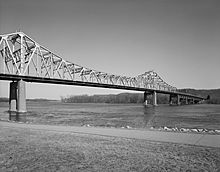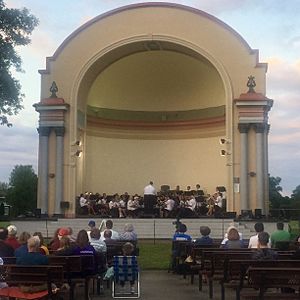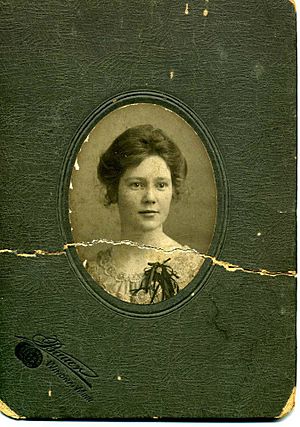Winona, Minnesota facts for kids
Quick facts for kids
Winona
|
|
|---|---|
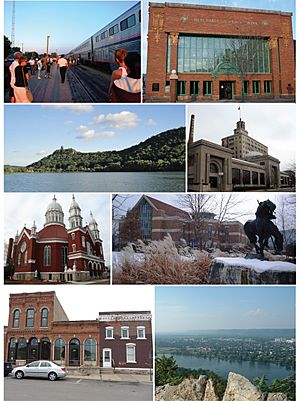
Left-to-right from top-left: the Empire Builder at Winona station, Merchants National Bank, Sugar Loaf, Watkins Incorporated, Basilica of St. Stanislaus, Krueger Library, East Second Street Historic Commercial District, and Garvin Heights City Park.
|
|
| Nickname(s):
The Island City
|
|
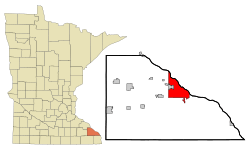
|
|
| Country | United States |
| State | Minnesota |
| County | Winona |
| Government | |
| • Type | Mayor - Council |
| Area | |
| • Total | 24.32 sq mi (62.98 km2) |
| • Land | 19.03 sq mi (49.29 km2) |
| • Water | 5.29 sq mi (13.70 km2) |
| Elevation | 655*–1,247* ft (200*–380* m) |
| Population
(2020)
|
|
| • Total | 25,948 |
| • Density | 1,377.28/sq mi (531.77/km2) |
| Time zone | UTC−6 (CST) |
| • Summer (DST) | UTC−5 (CDT) |
| ZIP codes |
55987
|
| Area code(s) | 507 |
| FIPS code | 27-71032 |
| GNIS feature ID | 0654269 |
| Website | City of Winona |
|
|
Winona is a city in and the county seat of Winona County, in the state of Minnesota. Located in bluff country on the Mississippi River, its most noticeable physical landmark is Sugar Loaf. The city is named after legendary figure Winona, who some sources claimed was the first-born daughter of Chief Wapasha of the Dakota people. The total of the city was 25,948 at the time of the 2020 census.
Contents
History
The city of Winona began on the site of a Native American village named Keoxa. The seat of the Wapasha dynasty, Keoxa was home to a Mdewakanton band of the eastern Sioux.
Non-Native Americans settled the area in 1851 and laid out the town into lots in 1852 and 1853. The original settlers were Yankee immigrants from New England. The population increased from 815 in December, 1855, to 3,000 in December, 1856. In 1856 German immigrants arrived as well. The Germans and the Yankees worked together planting trees and building businesses based on lumber, wheat, steamboating and railroads. For a time, Winona had more millionaires than any other city of its size in the United States.
The railroad and steamboat transportation industries helped Winona grow into a small city that diversified into wheat milling, and lumber production. In 1856, over 1,300 steamboats stopped at Winona. The railway system grew and the Winona Railway Bridge, built of steel and iron with a steam-powered swingspan over the river, was the second railway bridge to span the Mississippi. The first train crossed on July 4, 1891 and the bridge served the Green Bay & Western (GBW) and Burlington Route for the next 94 years until it was closed in 1985 and dismantled in the fall of 1990. In 1892, a wagon toll-bridge over the Mississippi, a steel high-bridge, was completed and remained in service until 1942.
Winona has two historic districts listed on the National Register of Historic Places that combine into a single local historic district administered by the city's Heritage Preservation Commission.
Geography
According to the United States Census Bureau, the city has a total area of 24.13 square miles (62.50 km2); 18.84 square miles (48.80 km2) is land and 5.29 square miles (13.70 km2) is water.
Winona's primary suburbs are Goodview, Stockton, Minnesota City and Rollingstone to the west, Homer to the southeast and Bluff Siding is 3 miles directly across the interstate bridge to the north and Fountain City to the north. Rochester is 44 miles to the west of Winona, La Crescent is 21 miles to the south, and La Crosse is 30 miles to the southeast.
Climate
Winona's weather station records the warmest climate of any in Minnesota, with a normal year-round average (1971–2000) temperature of 48.9 °F, compared to 43.2° in Austin to the city's southwest or 45.4° in Minneapolis, to the northwest, which experiences a strong urban heat island effect. Temperatures are generally very mild by Minnesota standards year-round; the January mean is 17.6°, while that of July is 75.8°.
| Climate data for Winona, Minnesota (1981-2010, snowfall&extremes 1893-present) | |||||||||||||
|---|---|---|---|---|---|---|---|---|---|---|---|---|---|
| Month | Jan | Feb | Mar | Apr | May | Jun | Jul | Aug | Sep | Oct | Nov | Dec | Year |
| Record high °F (°C) | 64 (18) |
73 (23) |
84 (29) |
96 (36) |
107 (42) |
106 (41) |
108 (42) |
103 (39) |
102 (39) |
93 (34) |
84 (29) |
65 (18) |
108 (42) |
| Average high °F (°C) | 27.0 (−2.8) |
32.4 (0.2) |
44.5 (6.9) |
60.5 (15.8) |
72.0 (22.2) |
80.6 (27.0) |
84.6 (29.2) |
82.3 (27.9) |
74.4 (23.6) |
61.1 (16.2) |
44.5 (6.9) |
29.9 (−1.2) |
57.8 (14.3) |
| Average low °F (°C) | 10.4 (−12.0) |
15.3 (−9.3) |
26.1 (−3.3) |
39.2 (4.0) |
50.3 (10.2) |
59.7 (15.4) |
64.4 (18.0) |
62.5 (16.9) |
54.1 (12.3) |
41.6 (5.3) |
29.0 (−1.7) |
15.4 (−9.2) |
39.0 (3.9) |
| Record low °F (°C) | −35 (−37) |
−33 (−36) |
−28 (−33) |
4 (−16) |
21 (−6) |
35 (2) |
43 (6) |
33 (1) |
25 (−4) |
7 (−14) |
−11 (−24) |
−27 (−33) |
−35 (−37) |
| Average precipitation inches (mm) | 1.17 (30) |
1.00 (25) |
1.93 (49) |
3.76 (96) |
3.86 (98) |
4.29 (109) |
4.21 (107) |
5.11 (130) |
3.93 (100) |
2.06 (52) |
2.43 (62) |
1.37 (35) |
35.12 (893) |
| Average snowfall inches (cm) | 10.09 (25.6) |
7.78 (19.8) |
8.58 (21.8) |
1.74 (4.4) |
0.05 (0.13) |
0.00 (0.00) |
0.00 (0.00) |
0.00 (0.00) |
0.00 (0.00) |
0.24 (0.61) |
3.24 (8.2) |
8.92 (22.7) |
40.64 (103.24) |
| Source 1: Western Regional Climate Center (Average Minimums/Maximums 1893-2011) | |||||||||||||
| Source 2: The Weather Channel (extreme temps) | |||||||||||||
Micropolitan area
The United States Office of Management and Budget has designated Winona as the principal city of the Winona, MN Micropolitan Statistical Area (µSA).
Demographics
| Historical population | |||
|---|---|---|---|
| Census | Pop. | %± | |
| 1860 | 2,464 | — | |
| 1870 | 7,192 | 191.9% | |
| 1880 | 10,208 | 41.9% | |
| 1890 | 18,208 | 78.4% | |
| 1900 | 19,714 | 8.3% | |
| 1910 | 18,583 | −5.7% | |
| 1920 | 19,143 | 3.0% | |
| 1930 | 20,850 | 8.9% | |
| 1940 | 22,490 | 7.9% | |
| 1950 | 25,031 | 11.3% | |
| 1960 | 24,895 | −0.5% | |
| 1970 | 26,438 | 6.2% | |
| 1980 | 25,075 | −5.2% | |
| 1990 | 25,399 | 1.3% | |
| 2000 | 27,069 | 6.6% | |
| 2010 | 27,592 | 1.9% | |
| 2019 (est.) | 26,594 | −3.6% | |
| U.S. Decennial Census 2018 Estimate |
|||
2010 census
As of the census of 2010, there were 27,592 people, 10,449 households, and 5,022 families residing in the city. The population density was 1,464.5 inhabitants per square mile (565.4/km2). There were 10,989 housing units at an average density of 583.3 per square mile (225.2/km2). The racial makeup of the city was 93.0% White, 1.9% African American, 0.3% Native American, 2.9% Asian, 0.5% from other races, and 1.3% from two or more races. Hispanic or Latino of any race were 1.7% of the population.
There were 10,449 households, of which 20.7% had children under the age of 18 living with them, 36.4% were married couples living together, 8.5% had a female householder with no husband present, 3.2% had a male householder with no wife present, and 51.9% were non-families. 35.6% of all households were made up of individuals, and 12.6% had someone living alone who was 65 years of age or older. The average household size was 2.24 and the average family size was 2.84.
The median age in the city was 26.7 years. 14.4% of residents were under the age of 18; 33.2% were between the ages of 18 and 24; 18.5% were from 25 to 44; 20.5% were from 45 to 64; and 13.3% were 65 years of age or older. The gender makeup of the city was 47.3% male and 52.7% female.
Sister cities
Landmark
- Sugar Loaf is a lighted, rocky pinnacle (remaining after quarrying activity) that arises from one of the many bluffs that line Highway 61. It is located at the junction of Highway 61 and Highway 43/Mankato Avenue.
Economy
Winona is home to the headquarters of the Watkins Corporation, Fastenal, Thern Inc., Knitcraft Corporation, RTP Company, We-No-Nah Canoe, United Building Centers, Badger Equipment Company, Winona Lighting, Hal Leonard Music, WinCraft Sports, and Winona Pattern & Mold. Bay State Milling operates a grain processing facility in Winona and was founded there in 1899.
Winona is also known as the stained glass capital of the United States. Winona is the setting of the Civil War era romance novel, Ladyslipper by Winona native, Donna G. Weber (1951–2012).
Top employers
According to the City's 2011 Comprehensive Annual Financial Report, the top employers in the city are:
| # | Employer | # of Employees |
|---|---|---|
| 1 | Fastenal | 1,420 |
| 2 | Winona Health | 1,200 |
| 3 | TRW Automotive Electronics | 775 |
| T-4 | Independent School District 861 | 712 |
| T-4 | Winona State University | 712 |
| 6 | WinCraft | 420 |
| 7 | Saint Mary's University of Minnesota | 391 |
| 8 | RTP | 375 |
| 9 | County of Winona | 291 |
| 10 | Watlow Electric Manufacturing Company | 290 |
Education
Winona became the site of the first normal school west of the Mississippi in 1858 with the establishment of Winona Normal School (now Winona State University). This was the beginning of Winona's tradition as a center of higher education. In 2018-2019, Winona State University (WSU) had approximately 7,200 undergraduate students and 560 graduate students. WSU is part of the Minnesota State college system.
Saint Mary's College (now Saint Mary's University) was founded as a private Catholic, Lasallian school in 1912. Later, as the necessary opportunity of higher education for women became apparent, the College of Saint Teresa was created. After Saint Mary's became co-ed in 1969, Saint Teresa closed down in 1988, and its facilities are now used, owned, and/or operated by Saint Mary's University of Minnesota, Winona State University, and Cotter High School. Minnesota State College-Southeast also has a campus in Winona.
There is a diverse variety of K-12 educational opportunities. Run by Independent School District 861, the local public school system includes five elementary schools (three in the city of Winona), the Winona Middle School, and the Winona Senior High School. The Winona Area Catholic Schools system includes St. Mary's primary school, St. Stanislaus Elementary School, Cotter Junior High School, and Cotter Senior High School. St. Martin's School, St. Matthew's School, and Hope Lutheran High School are private Lutheran schools in Winona. Two charter schools, Winona Riverway Learning Community (PreK-12) l, and Bluffview Montessori Charter School (K-8) are located in the city. Bluffview is notable as the first charter Montessori and the second charter school overall in the United States.
Main Square Montessori (MSM) is a nonprofit Montessori learning center for children from the ages of 16 months to six years old in a partnership between the Hiawatha Education Foundation and Cotter Schools.
Several organizations also provide community education. The Minnesota Conservatory for the Arts offers community classes for early childhood through 55+ adult programs in the areas of dance, music, theater, and visual arts. Winona Area Public Schools, Winona State University, The City of Winona Parks and Recreation, and Winona Arts Center offer additional community learning opportunities.
Transportation
U.S. Highway 14, U.S. Highway 61, Minnesota Highway 43 and Wisconsin State Highway 54 are the main routes into the city. Interstate Highway 90 is located a short distance south of the city.
Winona was once served by four railroads; Milwaukee Road (CMStP&P), Chicago & Northwestern (C&NW), Chicago Great Western (CGW) and Green Bay & Western (GB&W), with the Burlington Route (CB&Q) trains stopping at a station across the river in Wisconsin. Only the former Milwaukee Road station remains and is now served by Amtrak's Empire Builder daily in each direction between Chicago and Seattle and Portland. The Milwaukee Road is now Canadian Pacific, as is the Dakota, Minnesota & Eastern, which operates the former Chicago & North Western line from Winona to the west.
The Winona Transit Service provides public bus transportation six days per week. The city is also located along the Mississippi River Trail, and the Flyway Trail connects the city to nearby trail systems in Wisconsin. Winona Municipal Airport - Max Conrad Field serves general aviation in the area. It was once served by one passenger airliner, Mississippi Valley Airlines until the mid-1970s.
Notable people
- Carol Bartz, former CEO of Yahoo!, formerly of Autodesk
- Charles H. Berry, first Attorney General of Minnesota
- Bernhard Brenner, Founder/President of Knitcraft Corporation, manufacturer of St. Croix luxury knitwear
- Paul Breza, Roman Catholic priest and founder of Winona's Polish Cultural Institute and Museum
- Robert Henry Brom, Roman Catholic bishop
- Alec Brown, NBA player
- Elliott Heath, distance runner
- Garrett Heath, distance runner
- Roger Busdicker, co-founder of Hal Leonard Corporation
- Jan Romuald Byzewski OFM, pastor of Saint Stanislaus Kostka Parish and founder of the Polish-language newspaper Wiarus
- Tracy Caulkins, swimmer, three-time Olympic gold medalist
- Max Conrad, aviator
- James Earle Fraser (1876–1953), sculptor, designer of the Buffalo Nickel and the "End of the Trail" statue
- Paul Giel, athlete, two-time Big Ten Player of the Year, member of College Football Hall of Fame
- Mabel Farrington Gifford, expert on speech defects and disorders
- James "J. R." Keller, state senator and representative
- Bob Kierlin, businessman and politician
- John G. McMynn, Wisconsin Superintendent of Public Instruction
- William D. Mitchell, United States Attorney General under presidents Calvin Coolidge and Herbert Hoover
- Thomas H. Moodie, North Dakota governor
- Anne Pellowski, author, educator, and Kashubian American activist
- Benjamin H. Randall, American politician and businessman, early settler to Minnesota Territory
- Winona Ryder, actress
- Corey Schell, American professional bowhunter and archer
- Orlando Stevens, member of the state legislatures of Vermont and Minnesota
- Tom Stoa, Minnesota state legislator and beekeeper
- Eleanor Joy Toll, Los Angeles-area educator and clubwoman
- Joseph Ray Watkins, entrepreneur and founder of Watkins Incorporated
- Julie Wera, infielder with 1927 New York Yankees
- William Windom, actor
- William Windom (1827–1891), member of both the U.S. House of Representatives and U.S. Senate from Minnesota; later Secretary of the Treasury
- Cat Zingano, mixed martial artist
- Eugenia Wheeler Goff (1844-1922), historian, cartographer, educator, and author
Images for kids
-
A Mississippi River boathouse community can be found on Latsch Island.
See also
 In Spanish: Winona (Minnesota) para niños
In Spanish: Winona (Minnesota) para niños



